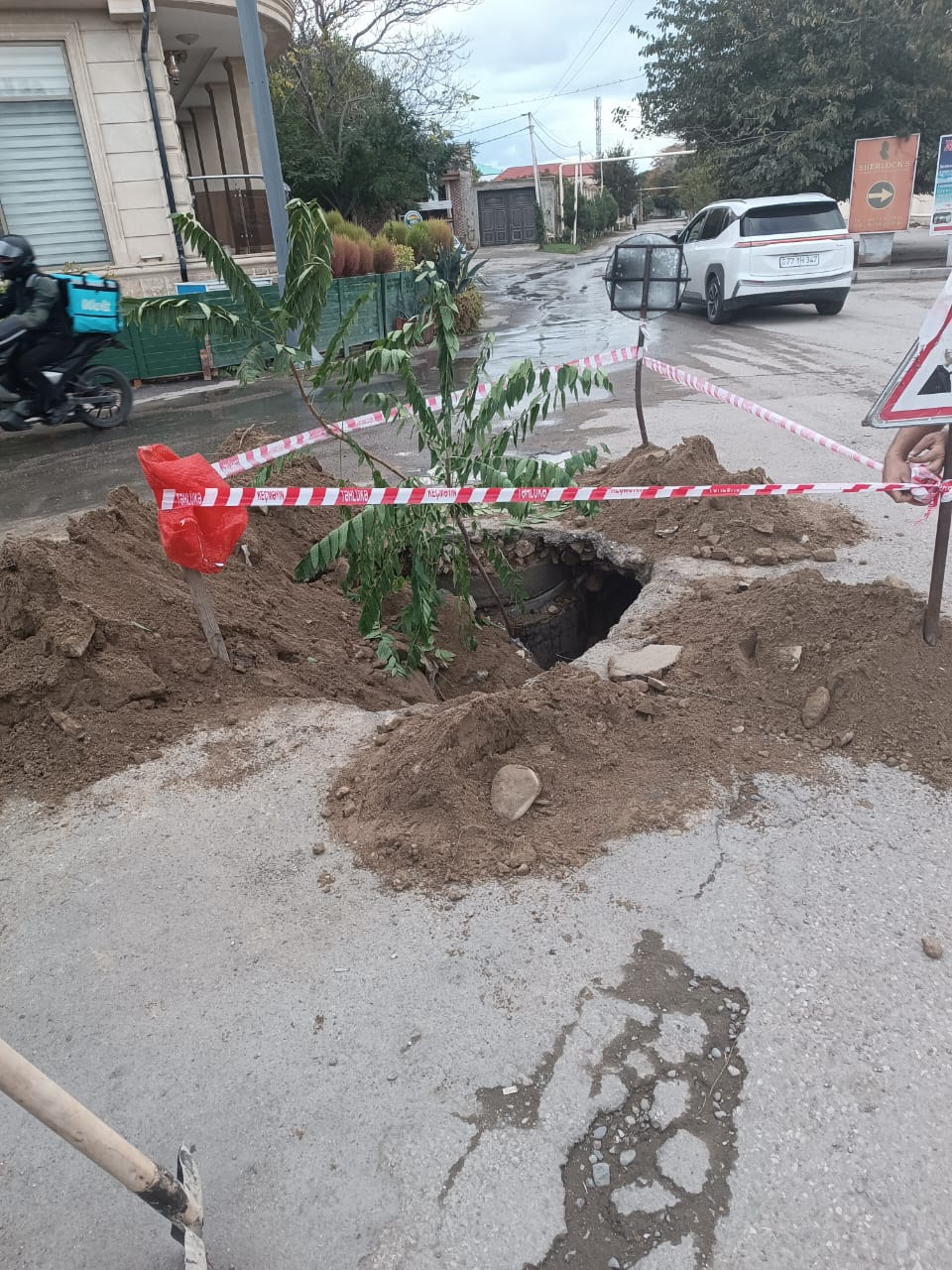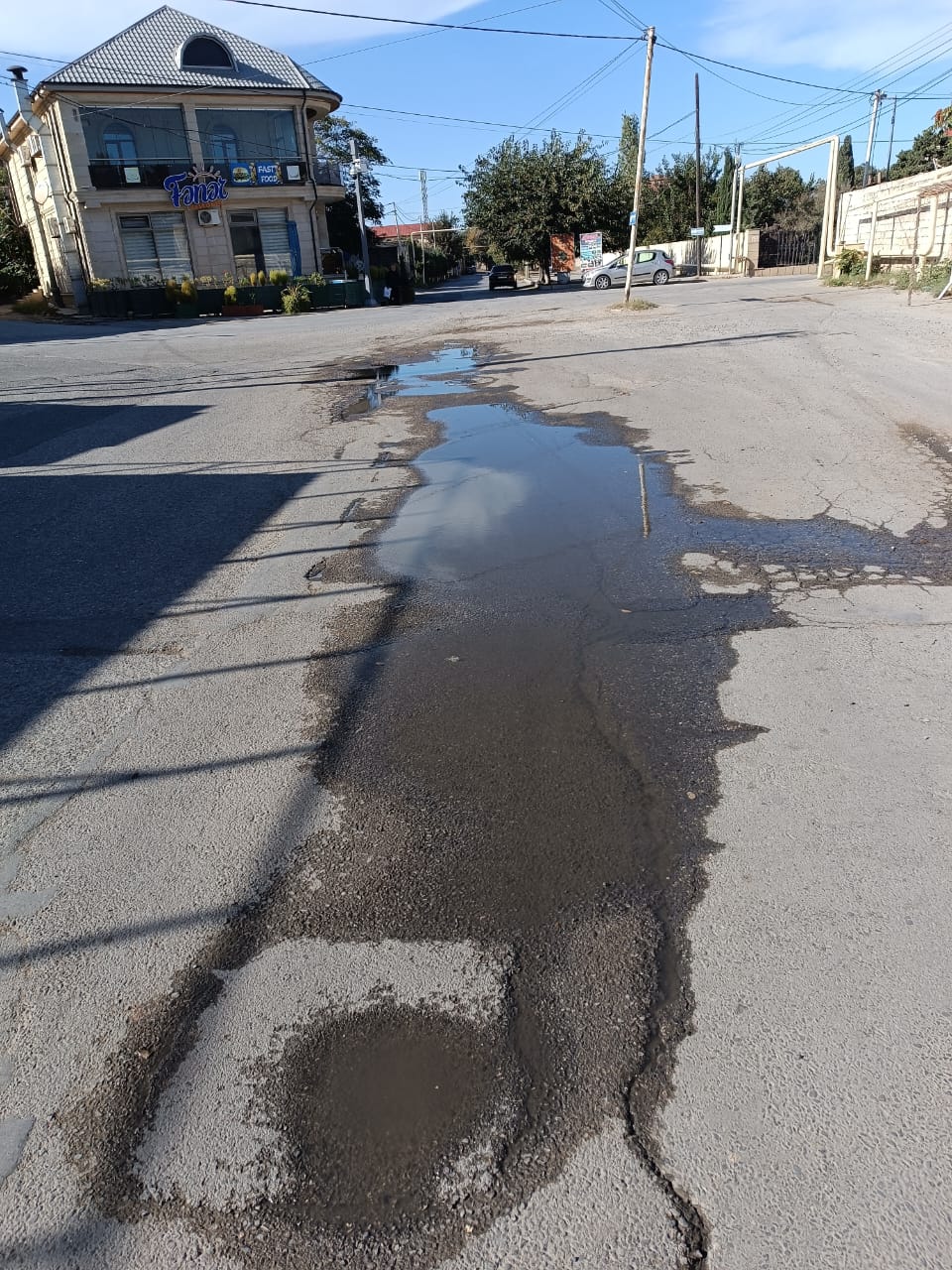
Zugulba. Photo Turan
On the eve of a large-scale flood approaching Baku, a disturbing incident occurred in the village of Buzovna, where a Lada Priora car fell into the ground, literally collapsing the road beneath it. The driver miraculously remained unharmed but vowed to seek justice, promising to file an official complaint with the prosecutor’s office against Azersu OJSC, the state-owned water supply and sewerage company, often associated with deeply rooted corruption.

Upon arriving at the scene, it was impossible not to notice the seriousness of the situation. Azersu workers were busy digging, hastily cordoning off the collapsed area with red-and-white-striped tape, meant to warn drivers of the potential danger. However, locals are all too familiar with this recurring issue, as the road has collapsed multiple times in the past six months. In fact, this very spot has repeatedly swallowed cars, turning what should be a standard road into a dangerous trap. Instead of taking decisive action, Azersu has become complicit, preparing yet another disaster waiting for its next victim.
This very location has been the subject of ongoing media coverage, with Turan, an independent Azerbaijani news agency, publishing a series of articles detailing the illegal and corrupt sewer line buried beneath these deteriorating roads. The sewer line, over two kilometers long, was laid in blatant violation of the law and, according to sources, was illegally commissioned by the Confederation of Trade Unions of Azerbaijan. Official documentation only surfaced after Turan's investigation in January—months after construction had already begun.
Requests for transparency were met with obfuscation. When Turan requested the required public documentation on the sewer line, as mandated by Azerbaijan’s Urban Planning and Construction Code, they were repeatedly blocked. The executive authority of the Khazar district admitted that the project had not been approved by their office, but shockingly, did nothing to stop it. Appeals to the Ministry of Ecology and the Committee on Architecture and Urban Planning were also ignored. Behind the scenes, inertia and complicity prevailed, allowing an illegal infrastructure project to turn into a public threat.
The results of this inaction are now painfully clear. The area around Buzovna is marred by accidents—sewage seeps onto the streets, the ground gives way, and entire sections of the road fall into disrepair. The more than two-kilometer stretch of road is now little more than a patchwork of hasty fixes, none of which address the root cause. Appeals to the government have gone unanswered, and locals are left to fend for themselves in a dangerous environment created by the very institutions meant to protect them.
The situation in Buzovna is not unique. For years, sewage has flowed unchecked into the waters surrounding nearby beach areas, including the pristine shores of Zagulba, right next to the presidential residence. Despite repeated articles, complaints, and public calls for action, nothing has changed. The sewage continues to flow freely onto public beaches like Buzovna and Zagulba, polluting the waters where families once swam and tourists once gathered.

The failure to maintain basic sanitary standards extends beyond the sewer system. In the summer months, trash blows freely across public beaches, often left by wandering livestock. I personally took it upon myself to clean the beaches, gathering trash into bags and calling the local authorities to have it removed. Though they came and collected what I gathered, the problem persisted—a constant cycle of neglect.
A similar scene unfolded at Bilga Beach. After my cleanup efforts, the Ministry of Ecology staged a widely publicized flash mob, complete with children waving flags, concerts, and a photo-worthy garbage collection event. But by early October, as the beach season drew to a close, I returned to find the same littered shore, where yet another flash mob was taking place—this time in preparation for the upcoming COP 29 conference.
In recent months, environmental fines have been increased. Ostensibly, these are meant to combat pollution, but they seem more like performative gestures than actual solutions. The government’s approach to environmental issues—and governance as a whole—appears to follow a pattern of reactive rather than proactive measures. Our government is Executive, not Proactive. They act only when directed to do so, and do nothing when they aren’t. The best-case scenario is a patchwork of quick fixes. The worst? A trail of flash mobs followed by man-made floods and disasters.
Azerbaijan, as it stands, lacks both a coherent strategy and the cultural commitment to landscape and environmental preservation that is so urgently needed. In Buzovna, the corruption beneath the surface—both literal and figurative—continues to spread, threatening to swallow more than just a car. It serves as a warning of what happens when institutions meant to protect instead turn a blind eye, leaving the public to sink in the chaos of their own making.
Previous articles:
Coastal Crisis in Azerbaijan: Hidden Sewage Discharges at Zagulba-Buzovna Beaches
Azerbaijan Marks National Press Day with Sewage Fountain
Is it possible to raise the standards of beach recreation amidst environmental issues?
Environmental crisis in Azerbaijan: sewage scandals and inactivity of state structures
Silence speaks volumes: Azerbaijan's struggle with transparency and accountability
Will Azerbaijani beaches raise "Blue flags"?
Construction of Immoral Water Supply System in Buzovna Accelerated
Construction of "immoral" water pipeline is suspended
Third Lawsuit against Azersu on Turan News Agency's Information Request





















Leave a review